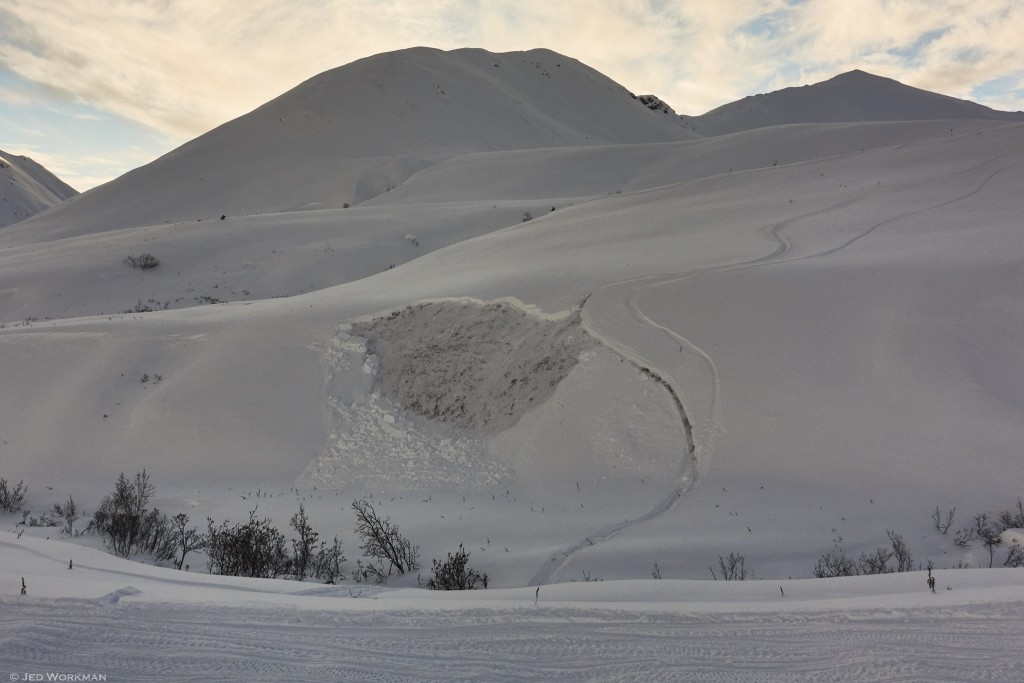| Trigger | Snowmachiner | Remote Trigger | 0 |
| Avalanche Type | Soft Slab | Aspect | West |
| Elevation | unknown | Slope Angle | 35deg |
| Crown Depth | 15in | Width | 30ft |
| Vertical Run | 35ft |
Avalanche: Hatcher Pass
Location: Microdot and Hidden Bowl avalanche, Willow side
Widespread natural avalanche activity peaked 1/25 – 26 from strong wind event overloading the snowpack, and a warming trend consolidating recent new snow into a cohesive slab. Slabs are failing on a weak layer of basal facets and depth hoar formed in October and November, in some cases sitting on an old melt freeze crust acting as a smooth bed surface just above the ground.
Natural activity has settled down, but human triggered avalanches continue to be sensitive to trigger on mostly steeper slopes, 35 degrees and steeper, on all aspects. However there have been some whumphing and shooting cracks on some slopes as low as 22 degrees, suggesting that in isolated to specific locations, lower angle slopes may be capable of producing human triggered avalanches.
Remotely, human triggered avalanches, were reported on the willow side by snow machiners a couple days ago. On 1/29 a snowboarder triggered a significant avalanche while walking a ridgeline. This avalanche partially buried a snowmachine on the flanks of the debris pile, no one caught or injured. A close call. Pictures below.
The basal facet weak layer is a very persistent and unreliable layer. It has gone through formation, activity, dormancy and back to activity at least a couple times, and this process is likely to continue the entire season until the layer is completely removed and flowing down the creeks in the spring. Propagation potential can be very high. In the recent natural cycle, avalanches propagated around ridge features. This kind of propagation will continue and poses a higher level threat, as predicting the potential boarders of an avalanche are more difficult, and the size of a potential avalanche also becomes more difficult to predict.
We traveled up into the Microdot area up to 4500′. We assessed the SSE aspect of Microdot and turned around and descended our skin track instead of skiing the main run on Microdot due to obvious recent signs of avalanches and deep, instability test results.
| Recent Avalanches? | Yes |
| Collapsing (Whumphing)? | No |
| Cracking (Shooting cracks)? | No |
While we did not experience whumphing or shooting cracks, others in adjacent areas did. Snowpack instability test results indicate a deep, unreliable weak layer capable of whumphing, shooting cracks and avalanches.
Clear, -12 C, calm wind, 5" new snow
Surface hoar in some locations sitting on new precipitation particles
Layer of concern: Weak basal facets and depth hoar at or near ground.
Instability impression: Moderate to high strength, poor structure, high energy, low friction, mixed continuity.
Pit locations:
West, 3600', 35 degrees, Steep test slope
West Northwest, 4000', 35 degrees, Fracture profile
South Southeast, 4500', 25 degrees, close to starting zone

1/29 snowmachine triggered gully sidewall, Fishhook Creek, along Willow Creek road near A-Frames

Recent natural avalanche likely 1/25 or 26, Microdot lowers, WNW, 4000'

1/25-26 -Natural avalanche, weak layer propagation around ridge features in Rae Wallace Chutes

1/25-26 Natural avalanche, Delia Creek Ridgeline

1/25-26 Natural avalanche, Arkose Ridgeline

1/29 - Hidden Bowl, machine partially buried on viewers left flank of debris.

1/29 - Starting zone Hidden Bowl. Snowboarder walked ridge and triggered this avalanche.

1/29 - Partially buried machine, no one or buried or injured

1/29 - Partially buried machine, no one or buried or injured